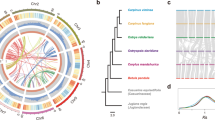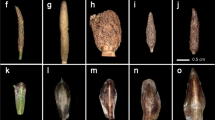Abstract
Main conclusion
The analysis of meiotic pairing affinities and genomic formulae in species and hybrids of Zea allowed us to speculate an evolutionary model to recreate the ancient polyploidization of maize and allied species.
Abstract
The meiotic pairing affinities and the genomic formulae analysis in Zea species and hybrids obtained in new and previous crosses, together with the molecular data known in the genus, allowed us to speculate an evolutionary model to attempt to recreate the ancient polyploidization process of Zea species. We propose that x = 5 semispecies are the ancestors of all modern species of the genus. The complex evolutionary process that originated the different taxa could be included hybridization between sympatric diploid ancestral semispecies (2n = 10) and recurrent duplication of the hybrid chromosome number, resulting in distinct auto- and allopolyploids. After the merger and doubling of independent genomes would have undergone cytological and genetical diploidization, implying revolutionary changes in genome organization and genic balance processes. Based on the meiotic behaviour of the 2n = 30 hybrids, that showed homoeology between the A subgenomes of all parental species, we propose that this subgenome A would be pivotal in all the species and would have conserved the rDNA sequences and the pairing regulator locus (PrZ). In the hypothetical model postulated here, the ancestral semispecies with the pivotal subgenome A would have had a wide geographic distribution, co-occurring and hybridizing with the semispecies harbouring B subgenomes, thus enabling sympatric speciation.




Similar content being viewed by others
Data availability
All data generated or analyzed during this study are provided in this published article or it will be provided from the corresponding author upon a reasonable request.
Abbreviations
- Mya:
-
Million years ago
- PrZ:
-
Pairing regulator locus
References
Alexander MP (1969) Differential staining of aborted and nonaborted pollen. Stain Technol 44:117–122
Birchler JA, Veitia RA (2007) The gene balance hypothesis: from classical genetics to modern genomics. Plant Cell 19:395–402
Birchler JA, Veitia RA (2010) The gene balance hypothesis: implications for gene regulation, quantitative traits and evolution. New Phytol 186:54–62
Birchler JA, Veitia RA (2012) Gene balance hypothesis: connecting issues of dosage sensitivity across biological disciplines. Proc Natl Acad Sci USA 109:14746–14753
Birchler JA, Bhadra U, Bhadra MP, Auger DL (2001) Dosage-dependent gene regulation in multicellular eukaryotes: implications for dosage compensation, aneuploid syndromes, and quantitative traits. Dev Biol 234:275–288
Birchler JA, Riddle NC, Auger DL, Veitia RA (2005) Dosage balance in gene regulation: biological implications. Trends Genet 21:219–226
Blasio F, Prieto P, Pradillo M, Naranjo T (2022) Genomic and meiotic changes accompanying polyploidization. Plants 11:125. https://doi.org/10.3390/plants11010125
Calfee E, Gates D, Lorant A, Perkins MT, Coop G, Ross-Ibarra J (2021) Selective sorting of ancestral introgression in maize and teosinte along an elevational cline. PLoS Genet 17(10):e1009810. https://doi.org/10.1371/journal.pgen.1009810
Doebley JF (1990) Molecular systematics of Zea (Gramineae). Maydica 35:143–150
Feldman M, Levy AA (2012) Genome evolution due to allopolyploidization in wheat. Genetics 192:763–774
Freeling M, Thomas BC (2006) Gene-balanced duplications, like tetraploidy, provide predictable drive to increase morphological complexity. Annu Rev Plant Biol 60:433–453
Gale MD, Devos KM (1998) Comparative genetics in the grasses. Proc Natl Acad Sci USA 95:1971–1974
Gaut BS, Doebley JF (1997) DNA sequence evidence for the segmental allotetraploid origin of maize. Proc Natl Acad Sci USA 94:6809–6814
González GE, Poggio L (2011) Karyotype of Zea luxurians and Z. mays subsp. mays using FISH/DAPI and analysis of meiotic behavior of hybrids. Genome 54:26–32
González GE, Poggio L (2015) Genomic affinities revealed by GISH suggests intergenomic restructuring between parental genomes of the paleopolyploid genus Zea. Genome 58:433–439
González GE, Comas C, Confalonieri VA, Naranjo CA, Poggio L (2006) Genomic affinities between maize and Zea perennis using classical and molecular cytogenetic (GISH-FISH). Chrom Res 14:629–635
González GE, Fourastié MF, Poggio L (2013) Número y composición de secuencias de los knobs (DAPI-FISH) y su utilidad en la caracterización de accesiones de maíz y teocintle. Rev Fitotec Mex 36:127–135
Grant V (1985) The evolutionary process: a critical review of evolutionary theory. Columbia University Press, San Francisco
Jenkins G, Rees H (1991) Strategies of bivalent formation in allopolyploid plants. Proc R Soc Biol Sci 243:209–214
Kovarik A, Dadejova M, Lim UK, Chase MW, Clarkson JJ, Knapp S, Leitch AR (2008) Evolution of rDNA in Nicotiana allopolyploids: a potential link between rDNA homogenization and epigenetics. Ann Bot 101:815–823
Leitch IJ, Bennett MD (2004) Genome downsizing in polyploid plants. Biol J Linn Soc 82:651–663
Matsuoka Y, Vigouroux Y, Goodman M, Sánchez J, Buckler E, Doebley JF (2002) A single domestication for maize shown by multilocus microsatellite genotyping. Proc Natl Acad Sci USA 99:6080–6084
Molina MC, López CG, Staltari S, Chorzempa SE, Moreno Ferrero V (2013) Cryptic homoeology analysis in species and hybrids of genus Zea. Biol Plant 57:449–456
Moore G, Devos KM, Wang Z, Gale MD (1995) Cereal genome evolution. Grasses, line up and form a circle. Curr Biol 5:737–739
Naranjo CA, Molina MC, Poggio L (1990) Evidencias de un número básico x=5 en el género Zea y su importancia en estudios del origen del maíz. Academia Nacional de Ciencias Exactas, Físicas y Naturales de Buenos Aires 5:43–53
Poggio L, González GE (2018) Cytological diploidization of paleopolyploid genus Zea: divergence between homoeologous chromosomes or activity of pairing regulator genes? PLoS ONE 13(1):e0189644. https://doi.org/10.1371/journal.pone.0189644
Poggio L, Molina MC, Naranjo CA (1990) Cytogenetic studies in the genus Zea: colchicine-induced multivalents. Theor Appl Genet 79:461–464
Poggio L, Confalonieri VA, Comas C, González GE, Naranjo CA (1999) Genomic affinities among Zea luxurians, Zea perennis and Zea diploperennis: meiotic behaviour in the F1 and genomic in situ hybridization (GISH). Genome 42:993–1000
Poggio L, González GE, Confalonieri VA, Comas C, Naranjo CA (2005) The genome organization and diversification of maize and its allied species revisited: evidences from classical and FISH-GISH cytogenetics analysis. Cytogenet Genome Res 109:259–267
Renny-Byfield S, Kovarik A, Kelly LJ et al (2013) Diploidization and genome size change in allopolyploids is associated with differential dynamics of low- and high-copy sequences. Plant J 74:829–839
Renny-Byfield S, Rodgers-Melnick E, Ross-Ibarra J (2017) Gene fractionation and function in the ancient subgenomes of maize. Mol Biol Evol 34:1825–1832
Ross-Ibarra J, Tenaillon M, Gaut BS (2009) Historical divergence and gene flow in the genus Zea. Genetics 181:1399–1413
Schnable JC, Freeling M (2011) Genes identified by visible mutant phenotypes show increased bias toward one of two subgenomes of maize. PLoS ONE 6(3):e17855. https://doi.org/10.1371/journal.pone.0017855
Schnable JC, Springer NM, Freeling M (2011) Differentiation of the maize subgenomes by genome dominance and both ancient and ongoing gene loss. Proc Natl Acad Sci USA 108:4069–4074
Soares NR, Mollinari M, Oliveira GK, Pereira GS, Vieira MLC (2021) Meiosis in polyploids and implications for genetic mapping: a review. Genes 12:1517
Soltis DE, Soltis PS (1999) Polyploidy: recurrent formation and genome evolution. Trend Ecol Evol 14:48–352
Soltis DE, Soltis PS, Rieseberg LH (1993) Molecular data and the dynamic nature of polyploidy. Crit Rev Plant Sci 12:243–273
Stebbins GL (1971) Chromosomal evolution in higher plants. Edward Arnold Ltd., London
Swigoñová Z, Lai J, Ma J, Ramakrishna W, Llaca V, Bennetzen JL, Messing J (2004) On the tetraploid origin of the maize genome. Comp Funct Genomics 5:281–284
Sybenga J (1975) Meiotic configurations. Springer, Berlin, Heidelberg, New York
Sybenga J (1996) Chromosome pairing affinity and quadrivalent formation in polyploids. Do segmental allopolyploids exist? Genome 39:1176–1184
Sybenga J (1999) What makes homologous chromosomes find each other in meiosis? A review and a hypothesis. Chromosoma 108:209–219
Sybenga J, Schabbink E, van Eden J, de Jong JH (1994) Pachytene pairing and metaphase I configurations in a tetraploid somatic Lycopersicon esculentum × L. peruvianum hybrid. Genome 37:54–60
Tenaillon MI, Burban E, Huynh S et al (2023) Crop domestication as a step toward reproductive isolation. Am J Bot 110:e16173
Tito C, Poggio L, Naranjo CA (1991) Cytogenetics studies in the genus Zea: DNA content and heterochromatin in species and hybrids. Theor Appl Genet 83:58–64
Wang L, Beissinger TM, Lorant A, Ross-Ibarra C, Ross-Ibarra J, Hufford MB (2017) The interplay of demography and selection during maize domestication and expansion. Genome Biol 18:215
Yang N, Wang Y, Liu X et al (2023) Two teosintes made modern maize. Science 382:eadg8940
Zafar Iqbal M, Cheng M, Zhao Y et al (2018) Mysterious meiotic behavior of autopolyploid and allopolyploid maize. Comp Cytogen 12(2):247–265
Acknowledgements
The authors would like to thank the Comisión Nacional de Investigaciones Científicas y Técnicas-CONICET (PIP 2115CO) and Universidad de Buenos Aires (UBACYT-20020170100614BA).
Author information
Authors and Affiliations
Contributions
GG and LP conceived and designed research, conducted experiments, analyzed data and wrote the manuscript. All authors read and approved the manuscript.
Corresponding author
Ethics declarations
Conflict of interest
The authors have no conflicts of interest associated with the article.
Ethics approval and consent to participate
Not applicable.
Consent for publication
Not applicable.
Additional information
Communicated by Dorothea Bartels.
Publisher's Note
Springer Nature remains neutral with regard to jurisdictional claims in published maps and institutional affiliations.
Rights and permissions
Springer Nature or its licensor (e.g. a society or other partner) holds exclusive rights to this article under a publishing agreement with the author(s) or other rightsholder(s); author self-archiving of the accepted manuscript version of this article is solely governed by the terms of such publishing agreement and applicable law.
About this article
Cite this article
González, G.E., Poggio, L. Polyploid speciation in Zea (Poaceae): cytogenetic insights. Planta 259, 67 (2024). https://doi.org/10.1007/s00425-024-04345-x
Received:
Accepted:
Published:
DOI: https://doi.org/10.1007/s00425-024-04345-x




